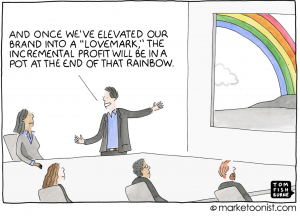Utility matters more than love for most brands
Tom Fishburne’s latest bit of cartoon genius below pokes fun at the ‘Lovemark’ concept coined by former Saatchi & Saatchi CEO Kevin Roberts back in 2005. This philosophy urged companies to cultivate ‘loyalty beyond reason’, even though there was zero data prove that this approach had any link to superior business results. Fast forward to 2017 and you still hear people quoting it, despite the lack of any evidence emerging to support it in the twelve years that have passed.
Below I look at some of the issues Tom raises in his article regarding loyalty.

1. Utility matters more than love
Many categories, and the brands in them, play a relatively small part in our lives, thank goodness; this leaves us free to get on with life. There are of course exceptions. I love the Harlequins rugby club ‘brand’, and have a soft spot for Orelebar & Brown swim shorts, for example. But these brands play in lifestyle categories, not everyday consumer goods ones. I love the quote from Ad Contrarian Bob Hoffman that Tom uses to illustrate this point:
“Creating a strong brand should be every marketer’s primary objective. But our industry has taken these truths and twisted them into silly fantasies. People have a lot of things to care deeply about. It’s very unwise to believe that they care deeply about our batteries, our wet wipes and our chicken strips.”
Rather than brands trying to get consumers to fall in love with them, a better route for most is to simply do their job as efficiently as possible. Being the most trusted brand to solve everyday problems is a noble cause for batteries, wet wipes and the like. In other words, utility more matters more than love for most brands. Sure, we can use emotion to tell memorable stories about our brands. But this emotional ‘sizzle’ needs to be combined with a clear idea of your product ‘sausage’. Emotional ‘connection’ is a means to and end, not an end in itself.
2. Penetration drives growth, not loyalty
Most marketers worth their salt have by now been exposed to the principles of ‘How Brands Grow’ by Professor Byron Sharp. The work of Byron and the team at the Errenburg Institute uses data to show how the key to brand growth is not in fact loyalty, but rather penetration i.e. how many people use your brand at least once a year. This is shown by data below from two shampoo brands in a presentation by Martin Weigel The top graph shows that most people are light buyers of the Fructis brand. The second graph shows that the key difference for the bigger Pantene brand is not more loyal users, but rather a lot more people buying it once a year i.e. higher penetration.
3. People have relationships with people, not your brand
Most people don’t want a “relationship” with your brand, nor to have a conversation with it. I love the quote below Martin Weigel uses to make this point, from former Mars CMO Bruce Mc Coll:
Data from our research paper, “Can Social Media Show you the Money”, shows that whilst marketers think people use social media for a “2-way conversation” with brands, consumers are really after information, entertainment and deals. This is why 99% of people don’t interact with a typical brand’s Facebook page.
In conclusion, most brands play a small role in our lives, and we buy lots of them, spending minimal time and effort in doing so. The challenge is to get noticed by as many people as possible to drive penetration. And this needs distinctive, impactful marketing about how your brand solve consumers’ problems or makes like a bit better. Brands fans who express ‘loyalty beyond reason’ can create some nice PR, As Martin Weigel showed in the visual below, but they are not the key to growth. What’s more, you are unlikely to have these sort of fans at all if you are selling pasta sauce and petfood rather than Prada.

